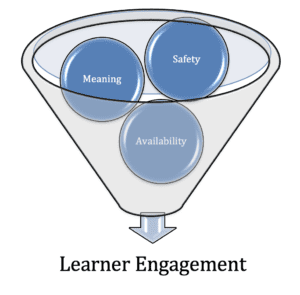
Learner engagement is one of the holy grails of learning businesses—if the learner isn’t engaged, learning is unlikely to happen. So what are the necessary circumstances that need to exist in order for engagement in learning to happen?
In this episode of the Leading Learning podcast, we delve into three conditions that have to be met to foster learner engagement: meaning, safety, and availability.
We also discuss some examples and ideas of how you might support those conditions in the products and services you create and deliver, and why your learning business should care.
To tune in, just click below. To make sure you catch all of the future episodes, be sure to subscribe by RSS, Apple Podcasts, Spotify, Stitcher Radio, iHeartRadio, PodBean, or any podcatcher service you may use (e.g., Overcast). And, if you like the podcast, be sure to give it a tweet!
Listen to the Show
Read the Show Notes
[00:18] – We’re going to start this episode a little differently than others. We’re going to start with a personal story.
Last April we went to see a play. It was called The Boy at the Edge of Everything by Finegan Kruckemeyer, and it was put on by a local middle school.
Friday night we volunteered to run concessions. We showed up, collected money, dispensed candy, and got to see the play, though in seats that were off to the side a bit.
All in all, it was a reasonably engaging production. We enjoyed it, though we had some trouble understanding what the actors were saying at times because our seats were off the side, and the actors weren’t always good about projecting when they spoke.
Now, as it happens, we went back to see the same play the next day, Saturday afternoon, and the experience was quite different.
This time, we didn’t volunteer for concessions. We sat front and center, so we could hear and see everything well, and we bought extended family along with us.
And here’s the really big difference: Our son, who was the understudy for the lead role, was actually playing the lead role in that second performance.
As you might guess, we were much more engaged for that second performance, and we’ve come to realize that there were very good reasons for this heightened engagement.
The three conditions necessary for engagement—meaning, safety, and availability—were met more fully the second time we saw the play.
The meaning was higher when our kid was starring.
Plus, in addition to our son playing a lead role in the second performance, we were also more familiar with the material, the storyline of the play, at that point, which served to bolster our interest.
The safety was higher because we had connected with some of the other parents by the second performance, and so we were more confident that it was a safe, accepting environment, even for actors who flubbed or forgot their lines, so that helped allay any anxiety we had about how our son would be received.
And our availability was higher at the second performance. The first time, running concessions took some mental space and effort, so we couldn’t give the play our full attention from start to finish.
The difference between our engagement with the first production and our engagement with the second production came down to meaning, safety, and availability.
And the same three conditions are necessary for engagement to happen in learning.
We tell this story to show it’s valuable for all of us to observe how engagement does or doesn’t happen in everyday life because what we observe can help us be more attuned to how engagement happens and give us ideas for how to support engagement in the educational experiences we develop and offer.
So, we’re devoting this episode to exploring the conditions that have to be in place if engagement is to happen.
Learner engagement is one of the holy grails of learning businesses—if the learner isn’t engaged, learning is unlikely to happen. We can plunk people down in the theater, but we can’t make them pay attention to the play.
But we can work to influence the conditions so they’ll want to watch—so they’ll want to learn.
Reflection Question

[01:55] – You might consider the reflection question below on your own after listening to an episode, and/or you might pull the team together, using part or all of the podcast episode for a group discussion.
- How well do you support the conditions necessary for engagement across your portfolio of learning products and services?
Defining Engagement
[04:01] – Before we go deeper on the conditions necessary for engagement, let’s define learner engagement, as it’s a term that doesn’t have a single clear, “right” definition.
But we can share a definition we like. It comes from the Glossary of Education Reform, and it says that learner engagement is:
the degree of attention, curiosity, interest, optimism, and passion that learners show when they are learning or being taught, which extends to the level of motivation they have to learn and progress in their education.
[Source: The Glossary of Education Reform. https://www.edglossary.org/student-engagement]
The Three Conditions Necessary for Engagement
[04:40] – There are three conditions that have to be met if learner engagement is to happen, if learners are to come to a learning experience attentive, curious, interested, optimistic, and passionate, if they’re to be motivated and make progress.
And those three conditions are meaning, safety, and availability.
Meaning refers to the sense that the effort needed to participate in a learning experience is relevant and will provide the learner with a return on investment.
Safety refers to the sense learners have of being able to participate as their true selves without fearing damage to self-image, status, or career.
And the third condition necessary for engagement is availability. Availability is the sense of having the physical, emotional, and psychological resources necessary to participate in a learning experience.
Meaning, safety, and availability are the conditions required for engagement.

But how can we, as learning businesses, support and leverage those conditions?
We have some ideas and examples we’ll share, and we encourage you to look at what you’re already doing to support meaning, safety, and availability and to brainstorm other ideas for how to further bolster them.
Your everyday experiences can offer insight—as we hope the opening story about our son’s play showed.
Meaning
[06:09] – To support meaning, use relevant examples and practice opportunities in your educational products and services. Practice doesn’t have to complicated.
Having attendees type ideas or answers to a problem into a chat box, for example, is a form of practice. But you do have to carve out the time for the practice, which means less presentation.
To support meaning, make sure to design chances for learners to experience results, so they get to see the logical outcomes and results of particular choices and decisions. Case studies and role playing can be great ways to do this.
To support meaning, give learners meaningful feedback.
Not just “That’s right—way to go!” or “No, sorry—try again.”
Meaningful feedback speaks to their particular approach to an activity or their specific answer choice to an assessment.
And also look for opportunities for learners to provide feedback to each other.
For more on the dos and don’ts of feedback, check out our episode, The Art and Science of Effective Feedback.
Meaning can also be bolstered by creating tension between where learners are now and where they want to be—and then resolving that tension, by teaching them things that help close that gap.
This works particularly well when promoting learning experiences, as it helps get at the “what’s in it for me,” but it also applies in the actual learning experience.
Structuring lessons as stories—giving them a narrative arc from presenting an initial problem then guiding learners to a resolution—is very powerful.
And, again, this doesn’t have to be complicated. Even something as simple as saying “there are 7 steps to dramatically increasing virtual conference registrations” or “there are 3 conditions for engagement” and then walking through those steps or conditions creates a sense of tension and resolution.
Safety
[08:39] – Let’s move on from meaning to safety, the second of the three conditions.
To support safety, make empathy part of your learning experiences.
Everyone providing and delivering the experiences—your designers and then your instructors and facilitators—needs to understand the learners’ needs and desires and focus on supporting their learning.
To do that, you should be in regular communication with your audience, continually soliciting input about their challenges and opportunities and then sharing that feedback with those on the front lines of developing and delivering your educational offerings.
As an example, we keep an open survey that we point new e-mail subscribers to ask about challenges and opportunities—that keeps us generally apprised of what’s going on.
We also do more targeted and specific questioning and surveying of potential learners when developing specific offerings.
A hallmark of our events, like our annual Learning • Technology • Design™ virtual conference, is to create the agenda in collaboration with the learners, so we’ll proactively seek feedback on potential topics and presenters.
To support safety, have policies in place that make it clear privacy and confidentiality will be respected—this will help learners be able to speak their mind, ask their real questions, share their real concerns.
You can do this as part of the sign-up or registration process for a learning experience, but it’s often important to reiterate it during the learning experience—it can be part of expectation setting at the beginning of a synchronous experience, whether online or off.
To support safety, let learners know it’s expected that they’ll make mistakes, and, in fact, mistakes are good because they’re valuable tools in learning.
Make sure you don’t shame or embarrass anyone for mistakes, but instead give good feedback that helps the mistake-maker—and other learners—understand what to do differently in the future.
Related to valuing mistakes, make sure your learning offers low-risk opportunities for failure (and thereby learning).
Depending on the field or profession you serve, the stakes can be lower or higher.
Obviously in medical professions or aviation, failure can mean life or death.
So you want learners to have a chance to fail in a safe setting, and technology is helping more and more here with XR, VR, and AR allowing those low-risk failures to mimic the real world as closely as possible, making them that much more valuable as learning experiences.
But you don’t have to be that high-tech to offer realistic opportunities for failure.
Again, case studies and role-playing exercises can be great tools and require nothing more than a representative scenario conveyed through simple text or audio.
And, lastly, emphasizing community will support safety.
You want your learning offerings to promote a sense of “We’re all in this together.” “Your success and learning is my success and learning,” and vice-versa.
Also, adult learners usually bring tremendous experience to a learning situation, and they may know as much about a topic-–or least particular aspects of a topic—as the facilitator or instructor; for everyone’s benefit you want to tap into the knowledge and experience the learners can share themselves, and you can do that by emphasizing a sense of community.
Availability
[12:37] – Now let’s talk about the last of the three conditions needed for engagement: availability.
To support availability, chunk the content into manageable segments.
You don’t want to overload your learners cognitively. Everything we learn has to go through our short-term memory, which is incredibly limited. Chunking makes more efficient use of our learners’ short-term memory by grouping information meaningfully.
John Medina’s Brain Rules is a great resource on chunking, if you want a deeper dive.
Another way to support availability is to make sure your content is accurately leveled—that is, make sure to align the content to learners’ prior knowledge and experience.
To support this, you might need to do some pre-assessment or, at least, make sure your course or session descriptions are very clear about the level at which the material will be taught.
And, lastly, either provide or make clear in advance what learners need to fully participate in the learning experience.
This could be everything from required reading to laptop or pen and paper to time carved out for full attention and quiet space for reflection.
Why Care About Engagement?
[13:59] – So that’s our look at a few ways to promote the three conditions required for learner engagement.
We’ll wrap by asking so what? Why do we as learning businesses care about learner engagement?
Engagement makes for an improved experience for the learners—it’s going to be better, nicer, more meaningful for them if they’re engaged—but what about for the learning business?
Well, if learners are engaged, they’re probably learn better. They’ll likely be better able to apply what they’ve learned.
So engagement helps with learning effectiveness. And from the learning business perspective, that’s huge. That’s the kind of effectiveness that drives the triple goals of reach, revenue, and impact that we like to talk about—see our related episode, Reach, Revenue, and Impact.
And learner engagement helps increase the reach, revenue, and impact of a learning business.
Engaged learners are best positioned to realize the full impact of your learning offerings as they apply what they learn.
Engaged learners are going to help you reach more of the right learners by telling others about your offerings.
And engaged learners can help to increase revenue through referrals and by returning to you for additional learning products and services.
[15:19] – Wrap-Up
Reflection Questions

- How well do you support meaning, safety, and availability across your portfolio of learning products and services?
If you are getting value from the Leading Learning podcast, be sure to subscribe by RSS, Apple Podcasts, Spotify, Stitcher Radio, iHeartRadio, PodBean, or any podcatcher service you may use (e.g., Overcast) as it helps us get some data on the impact of what we’re doing.
We’d also appreciate if you give us a rating on Apple Podcasts by going to https://www.leadinglearning.com/apple. We personally appreciate your rating and review, but more importantly reviews and ratings play a big role in helping the podcast show up when people search for content on leading a learning business.
Finally, consider following us and sharing the good word about Leading Learning. You can find us on Twitter, Facebook, and LinkedIn. We also encourage you to use the hashtag #leadinglearning on each of those channels. However you do it, please do follow us and help spread the word about Leading Learning.
[17:14] – Sign off
See Also:


 Could Associations Replace College? (Take 2)
Could Associations Replace College? (Take 2)
Leave a Reply